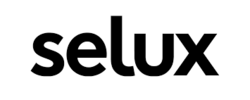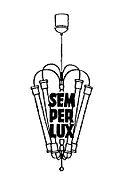Selux
| Selux AG
|
|
|---|---|
| legal form | Corporation |
| founding | 1948 |
| Seat |
Berlin Germany |
| management | Jürgen Hess, Markus Schiebold, Peter Stanway |
| Number of employees | 211 |
| sales | EUR 37.5 million |
| Branch | Lighting technology |
| Website | www.selux.com |
| As of November 16, 2019 | |
The Selux AG is a 1948 Semperlux Manufacturer of lighting equipment . The company, based in Berlin and with locations in Europe , North America and Australia, develops and produces lighting technology for indoor and outdoor lighting. Well-known projects are the 9/11 Memorial Museum in New York , the Barangaroo Reserve in Sydney and the Museum for Architectural Drawing in Berlin.
history
Founded in 1948
After his return as a company commander on the Eastern Front, the electrical engineer Hermann Bansbach constructed a battery charger during the Berlin blockade , which he called Semperlux ("Always Light"). The device could be used to recharge energy in the two hours when electricity was available. After the end of the blockade and the restoration of electrification, Hermann Bansbach built the first interior lights made of wood and the then largely unknown fluorescent lamps . The new types of lights sold well and so the light maker decided to work with metals such as brass and aluminum instead of wood. This resulted in the well-known Semperlux Kronen lamp.
Semperlux GmbH
In the 1950s, the company produced functional lamps and decorative lamps almost exclusively by hand. Sales rose continuously: from 51,000 DM in 1952 to 256,000 DM in 1954.
In a team of 12 employees and together with his son Armin Bansbach (then an electrical engineering student at the TU), Hermann Bansbach developed new lamp models: linear lamps with glass (1954), louvre lamps (1955), cassette lamps (1964) and system lamps.
The first major orders followed in 1961: IBM administration building on Ernst-Reuter-Platz in Berlin (1961), the Deutsche Oper Berlin (1961), the Brücke-Museum Berlin (1966/67) and the Ethnological Museum (1964/73). In addition to the range of standardized lights, special lights were also increasingly being manufactured.
In 1963 Armin Bansbach, the older son of the company founder Hermann Bansbach, took over the management. In the same year, Semperlux had new production areas built on Tempelhofer Weg in Berlin-Britz. The move to the new production building marked the change from a simpler manual production method to industrial processing using modern machines.
In 1965 Armin Bansbach came back from a trip to the USA with the idea of a spherical lamp. These were of particular interest to housing associations. Semperlux was the first company in Europe to launch a range of impact-resistant spherical lights for public as well as private use. In 1972 Semperlux equipped the outdoor area for the Olympic Games in Munich with spherical lights and in 1976 the Sydney Opera House .
In 1975 Udo Bansbach, Armin Bansbach's younger brother, joined the company and took on responsibility for development and sales. During this time the company developed profile lights made of extruded aluminum. The Berlin universities, the Museums for Prussian Cultural Heritage (Berlin) and the Landeszentralbank in Hamburg began to install Semperlux lights. The outdoor lighting range has been expanded to include postmodern lights such as the Metropolitan candelabra and Urbi lamp, as well as historical outdoor lights such as the Hardenberg and Witzleben candelabra.
In the 1970s, the company was one of the first to develop the so-called mirror profile cassette light - a light system made from aluminum profiles. The innovation consisted in the fact that the lights were no longer offered as piece goods, but as yard goods in a modular system . Since then, this type of interior lighting has also been part of the standard range of other manufacturers.
In the 1980s, Semperlux had already established itself as a manufacturer of indoor and outdoor lights throughout Germany. The export business - especially to Holland and Saudi Arabia - grew enormously. Semperlux expanded international sales structures and agencies abroad and won a number of major projects in the interior and exterior area. From 1979 to 1980 the company's turnover rose by 21 percent to 19.1 million DM. In 1983 Semperlux moved into a new production building with a usable area of 18,000 m² in Berlin-Marienfelde, the number of employees rose to 190. In the years that followed, the company became international Subsidiaries founded by Semperlux: Selux Corporation in the USA (1984), Ludec in France (1988), in England and Australia (1989) and in the Benelux countries (1991).
Semperlux AG
In 1991 the demand for outdoor lighting in the new federal states increased. A new production facility for outdoor lights for around 100 employees was built in Zachow near Nauen. From 1995 candelabras, steel masts and lanterns were produced here. In Zwintschöna near Halle, Semperlux acquired a metal processing company with 75 employees, which was supposed to take over the urgent expansion of interior lighting production. The plant was closed in 2018 and the rights of use in the area of interior lighting were sold in 2019. In 1997 Semperlux GmbH merged with Selux AG Holding to form Semperlux Aktiengesellschaft - Lichttechnische Werke. The main factory in Berlin became the parent company of 15 domestic and foreign subsidiaries.
Selux AG
On July 1, 2001, at the age of 67, Armin Bansbach retired from day-to-day business as a member of the Semperlux AG board. Udo Bansbach remained active in the company until 2015. From 2009 to 2015, Selux made a smooth transition from a family-run to a management-run company. In 2012, Semperlux AG was renamed Selux AG and the sole shareholder of Selux AG, Hermann Bansbach GmbH & Co. KG, was renamed Semperlux Beteiligungs GmbH & Co. KG.
Closure of the interior lighting plant
In mid-2018, the management at the time announced that they would close the plant in Zwintschöna near Halle and no longer want to produce interior lighting in the future. The Berlin location was also affected by redundancies for operational reasons in the same year.
In May 2019, the company announced that it had sold the rights of use for products for indoor use in Europe to Ridi Leuchten GmbH and had licensed production and sales. The American subsidiary Selux Corporation is not affected by the sale of the rights of use.
Selux AG is acquired by equity funds
An equity fund represented by CMP Capital Management-Partners will take over Selux AG in October 2019. CMP GOF III Holding S.à.rl, Luxembourg, has announced that it directly owns more than one fourth of the shares in the company. Neither the Hermann Bansbach Family Foundation nor Semperlux Beteiligungs GmbH & Co. KG hold a majority in Selux AG. The seat of Selux AG remains in Berlin, the production site in Zachow near Ketzin (Brandenburg) will be continued. In October 2019, a reconciliation of interests and a social plan were agreed with the group works council. Then there were job cuts at the end of the year. The board of directors and the supervisory board were largely renewed.
Historical lighting museum
In 2005, the Senate Building Director Hans Stimmann opened the Historical Lighting Museum in Selux (then Semperlux) Light Forum on Motzener Strasse in Berlin. The museum presents a collection of historical outdoor lights from the period between 1850 and 1914 and is dedicated to the history of electric street lighting in Berlin. Among a variety of classic original lights, the museum shows the Schupmann candelabra , the Steglitzer light and the "icon of industrial design", the large savings arc lamp by Peter Behrens from 1907. How the arc phenomenon works can be seen during the demonstration of a Look at over 120 years old, still functional carbon arc lamp .
literature
- Sabine Röck: Berlin illuminated. The Semperlux story . 1st edition. B & S Siebenhaar, 2003, ISBN 978-3-936962-04-8 .
- Franziska Nentwig, Beate Binder, Dominik Bartmann , Stiftung Stadtmuseum Berlin, Märkisches Museum: Berlin in Light . 1st edition. G & H Verlag, Berlin 2008, ISBN 978-3-940939-06-7 , pp. 99,214,217 .
Web links
Individual evidence
- ↑ Number of employees according to the 2017 annual financial statements in the electr. Federal Gazette
- ↑ Sales according to the 2017 annual financial statements in electr. Federal Gazette
- ^ Röck, Sabine, 1962-: Berlin illuminated: the Semperlux story . 1st edition Bostelmann & Siebenhaar, Berlin 2004, ISBN 3-936962-04-9 , pp. 239 .
- ↑ Natalie Gommert: A figure of light, always in front. In: Potsdamlife issue 43, spring 2016, pp. 72–76.
- ↑ Lars Spannagel: Zachow lets Berlin shine: lamps from Habelland have been standing at the Brandenburg Gate since yesterday In: Märkische Allgemeine October 11, 2005
- ↑ Jens Wegener: Zachower's success story: Semperlux lights are in Berlin and many other places in the world. In: The Havelländer May 15, 2007
- ↑ Klaus Stark: Lamps for Oxford Street: At Semperlux not only historical candelabra are reconstructed In: Märkische Allgemeine Friday, June 15, 2007, p. 29
- ^ A b IG Metall Berlin: Selux: The light goes out inside. Retrieved November 16, 2019 (German).
- ↑ a b Selux - Selux AG focuses on smart outdoor lighting: Interior lights "Designed by Selux" in future by Ridi. Retrieved November 16, 2019 .
- ↑ Entry in the Federal Gazette. Retrieved February 10, 2020 .
- ↑ Alfons Oebbeke: Equity fund represented by CMP acquires Selux. Retrieved February 10, 2020 .
- ↑ Commercial register announcement. Retrieved February 10, 2020 .
- ↑ Paul Ponizak: Lauter lamps In: Berliner Zeitung October 25, 2005
- ↑ CvL: as Schupmann candelabra and Steglitzer lights illuminated the city in: Tagesspiegel 21 October 2005




